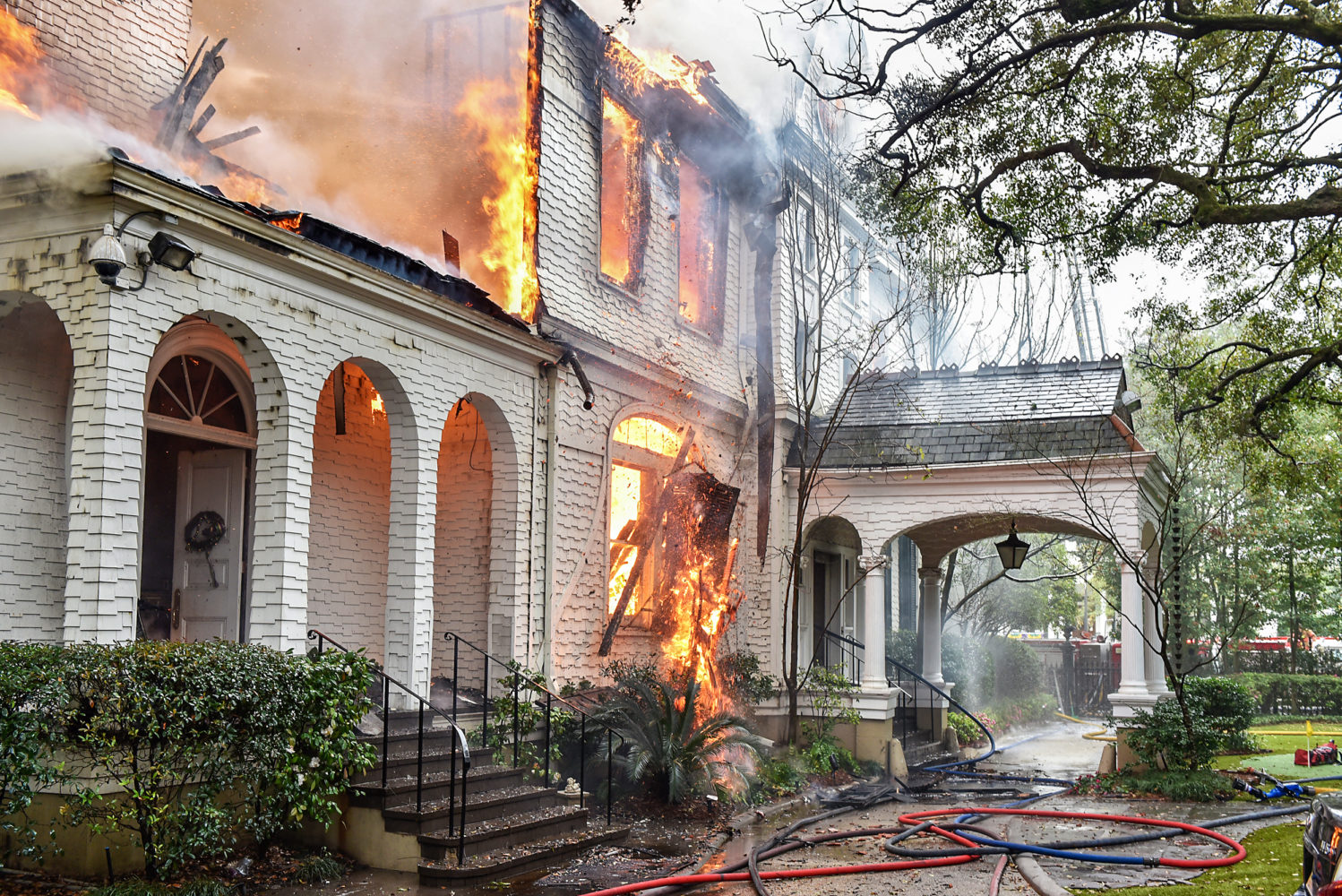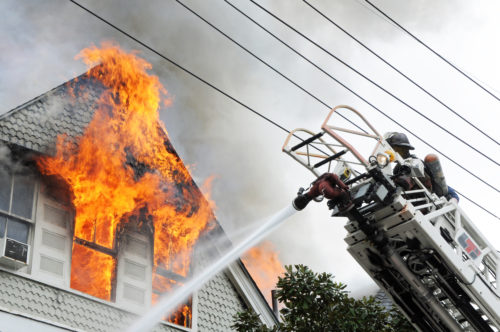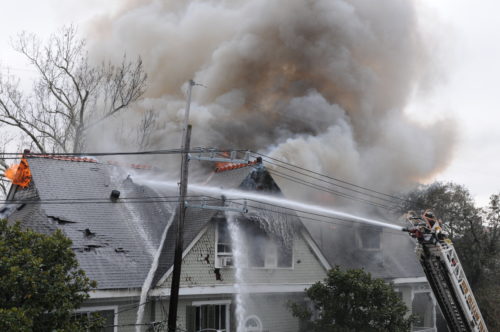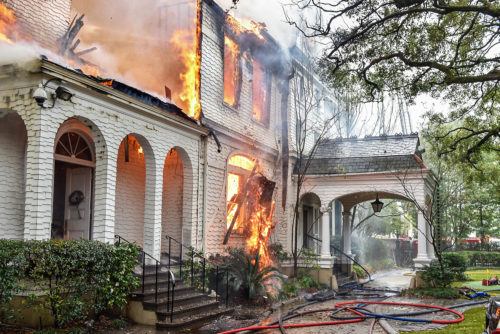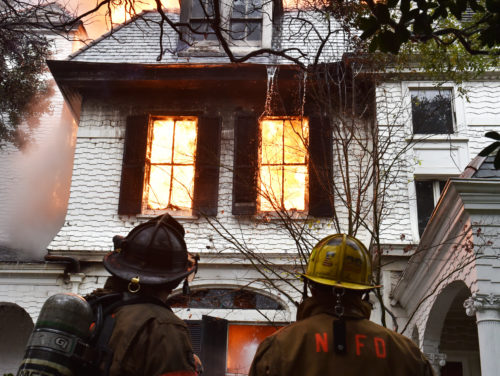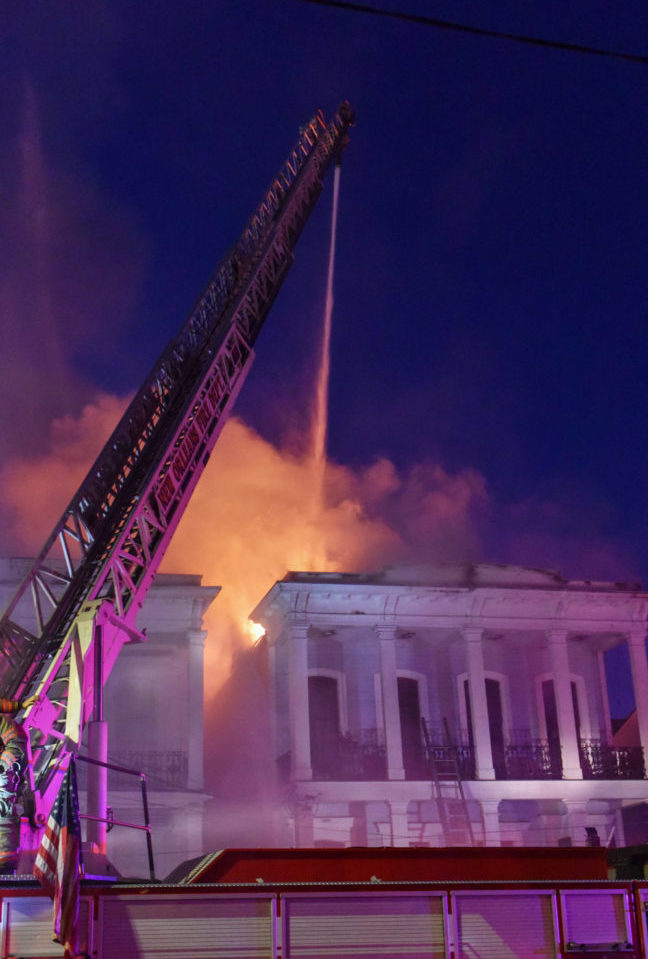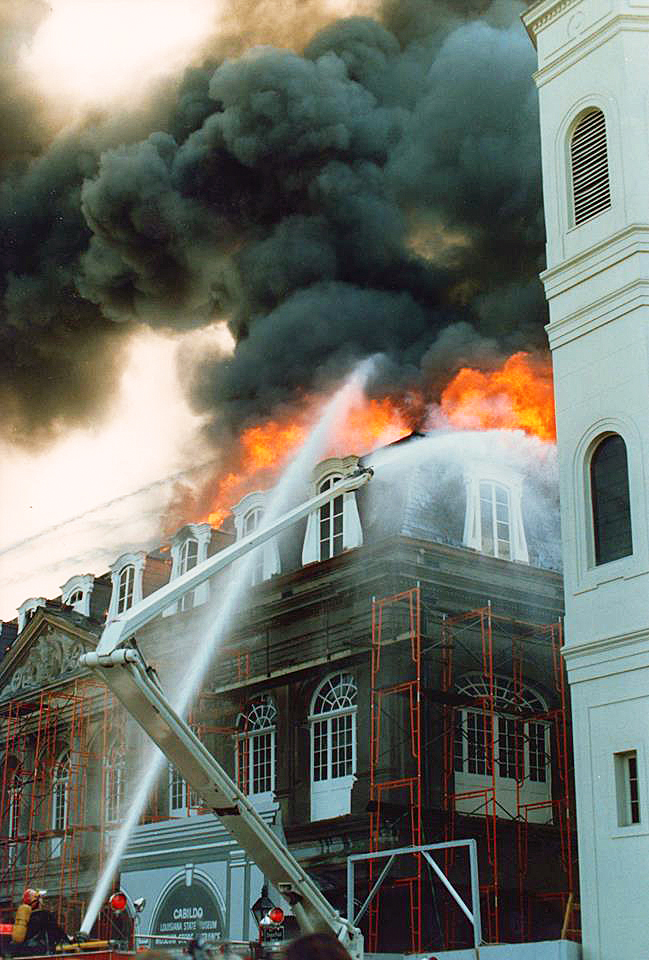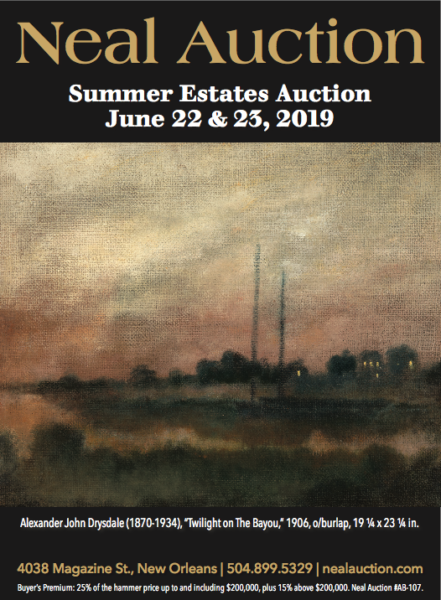This story appeared in the June issue of the PRC’s Preservation in Print magazine. Interested in getting more preservation stories like this delivered to your door monthly? Become a member of the PRC for a subscription!
Architect Robert J. Cangelosi, Jr.’s phone started ringing after a seven-alarm fire on Feb. 20 destroyed the Montgomery-Grace mansion at 2525 St. Charles Ave., the circa 1865 Queen Anne-style house where the king of Carnival stops for a toast on Mardi Gras. News reports of the mansion’s construction and the way the fire quickly spread from the basement up three floors had other property owners concerned their historic homes might be vulnerable to such destruction.
Cangelosi, who also is an architectural historian, got another call after news reports on April 15 showed flames shooting from the roof of the 800-year-old Notre Dame Cathedral in Paris. That call came from a client with a 150-year-old home in Natchez, Miss., who wanted Cangelosi to investigate possible fire escape routes from a second-floor bedroom.
“A lot of people are thinking about this,” he said.
Fire does not respect historic buildings. “Wood tends to be drier and more brittle quite often in older buildings, so they do tend to be tinderboxes for the most part,” Cangelosi said. Yet property owners can be proactive. Thinking holistically about potential fire risks and prevention strategies — some of which can be done for little to no cost — is the best approach to protecting properties from ruinous blazes. That includes checking electrical systems, being smart about other potential risks, and employing good renovation techniques. Having good detection and suppression systems and a fire escape plan also are vital.
In 2015, the third floor of a Garden District gem caught on fire. Firefighters worked tirelessly to contain the damage. The newly renovated house was featured on the PRC’s 2018 Holiday Home Tour. Photos by New Orleans Fire Department District Chief Chris E. Mickal for NOFD Photo Unit
Electrical hazards
The cause of the Montgomery-Grace fire in New Orleans has not been released, but in Paris, police investigators believe Notre Dame’s fire resulted from an electrical short, according to various news reports. Electrical issues are a major source of fires, Cangelosi said.
After a four-alarm blaze in 2015, he worked with the Trufant family to restore their 1890s Queen Anne-style house in the Garden District. An electrical short in the HVAC system junction box sparked that fire, which “burned down as well as up,” he said.
Cangelosi said a licensed electrician can perform an electrical Insulation Resistance Test to look for problems. For historic buildings with significant contents and collections, he often suggests the owners have this test performed every five to 10 years as part of a cyclical maintenance program, he said.
The New Orleans Fire Department inspects “commercial facilities to make sure that they’re compliant with all fire codes,” said spokesman Louis Carrier, a public information officer with the department’s Community Relations Division. At a homeowner’s request, the department also can inspect a residential building.
“That’s not something we normally do; we don’t have access to people’s homes unless they’d like for us to come in and give them an idea of what may be some hazards,” Carrier said, adding that the department also offers community fire-prevention programs for children, seniors and workplaces.
The NOFD’s website, nola.gov/nofd, also includes the following electrical fire prevention tips:
- do not overload circuits;
- do not put cords or wires under rugs in high traffic areas;
- professionally repair or replace outlets that sputter or emit an odor;
- turn off, then replace or repair, appliances that are overheating or have unusual smells, shorts and sparks;
- and use safety caps to cover unused outlets, especially when small children are present, the website says.
Advertisement
Heat hazards
Open flames and other heat sources always should be closely monitored. Fireplace flues should be kept clean, and common sense should be employed, Cangelosi said. Don’t store “a whole lot of stuff that’s combustible in your basement or your attic,” he said. “If you have a gas water heater, check it and make sure combustible materials are kept from being in contact with it.”
Don’t store paints or gasoline in homes. Instead, keep them in a well-ventilated detached garage or a shed away from the main structure. Don’t smoke inside, and don’t leave grease on the stove.
“Everyone should have in their own home a working fire extinguisher, particularly in the kitchen for potential grease fires. Make sure it’s rated for a variety of types of fires,” Cangelosi said, adding that the devices are required in residences larger than a duplex.
And don’t let candles burn unattended. The May 25, 2003, fire of the historic Blessed Francis Seelos Catholic Church — known as St. Vincent de Paul Catholic Church before several parishes were combined in 2001 — was caused by “candles left in church behind the altar,” Cangelosi said. The main altar was destroyed, along with several murals and the sacristy.
Property owners also should ensure open flames are minimized during renovations and other construction projects. An open flame was to blame when the Cabildo burned in 1988, destroying the third floor and causing heavy smoke and water damage to the first two floors. Hundreds of artifacts, including much furniture and several rare maps and paintings, were destroyed or damaged.
It was a “workman using improper techniques to solder the building, and that was determined by three independent cause-and-origin reports,” said Cangelosi, who oversaw the restoration of the 1795 building. “When workmen are working on a building, you want to use construction techniques that minimize open flames, and if they are absolutely, positively necessary, you want to have a fire watch” — someone with a fire extinguisher and with communications directly to the fire department.
A big hazard is using an open flame to get paint off of woodwork, Cangelosi said. “That is one of the worst things you could possibly do; that’s just asking to burn your building down,” he added. A better alternative is to use a chemical process to remove paints and sealers. Cangelosi uses Blue Bear Soy Gel.
2525 St. Charles went up in flames this past February, only weeks before Rex would stop by for its obligatory Mardi Gras toast. Photos by New Orleans Fire Department District Chief Chris E. Mickal for NOFD Photo Unit.
Secure vacant buildings
Securing vacant buildings is another smart fire-prevention strategy. “If it’s vacant, you need to warehouse the property, and there are guidelines for that — what you secure and things to prevent intrusions,” Cangelosi said. This will keep squatters from entering the building and lighting fires to cook or keep warm.
A homeless man “started a fire in an alcove of 1016 Canal St. in the early morning hours of Jan. 27, 2016, to stay warm,” according to reports in The Times-Picayune. “The flames quickly spread into a massive blaze that took firefighters more than eight hours to bring under control.” The fire destroyed the historic building at 1016-1022 Canal St. and spread to neighboring properties.
Fire alarms and sprinkler systems
The best fire prevention comes from good detection and suppression. Top among them is installing smoke detectors and fire alarms, which Cangelosi said are required outside bedrooms per fire codes.
State Fire Marshal Butch Browning recommends installing fire detection systems that can be monitored off-site by a service that can dispatch firefighters in the event of an emergency.
Hard-wired detection systems are best, Carrier said, but any fire alarm is better than none. Through the New Orleans Fire Department’s Free Smoke Detector Installation Program — made possible from donations to the Friends of the New Orleans Fire Department — NOFD will install two smoke detectors powered by 10-year lithium batteries at homeowners’ request. The department also will replace batteries of smoke alarms in the homes of elderly or physically challenged people, and offers deaf and hard-of-hearing residents smoke alarm systems that consist of a strobe light, vibrating bed/pillow shaker or traditional audible alarms. Property owners can make a request for any of these services via nola.gov/nofd.
Browning’s No. 1 suggestion to minimize fire risks in historic properties is to install a sprinkler system. “Many times, the argument for retrofitting historic buildings with fire sprinklers is cost,” he said. “When you see how tragedy can strike in the form of fire spreading uncontrollably through something people consider priceless, the cost to preserve it with fire protection becomes worth it.”
Carrier echoed the wish to see more residential sprinkler systems. “Any type of system in place to help suppress a fire before it gets to a larger stage is really one of the most important things we can stress to people,” he said.
Another fire-prevention strategy can involve installing lightning rods. While they do not decrease the likelihood that a building will be struck by lightning, they do provide a direct path to the ground for the electrical currents, reducing or preventing damage. St. Patrick’s Church in New Orleans kept getting hit even after Cangelosi’s firm, Koch and Wilson Architects, installed lightning protection systems that included rods and surge protectors. One strike caused a brick finial to crash to ground. To develop a plan in case a fire should erupt in the church, his firm consulted with the New Orleans Fire Department and took all three shifts of firefighters through the building to familiarize them with the layout. The church also strengthened certain spots in the building at firefighters’ request.
“That’s not what the average person is going to do in their home,” Cangelosi said, “but if you have a major landmark, it’s worthwhile to work with your fire department and have them make any suggestions when you walk them through the building.”
Advertisement
The importance of a fire plan
Should a fire break out, smart strategies are key.
Both the New Orleans Fire Department and architect Robert J. Cangelosi, Jr., who has helped restore many fire-damaged buildings, stressed the importance of a fire plan. The department’s website lays out the steps needed to create one.
They include:
- draw a map of the building showing all windows and doors and two ways out of every room
- make sure windows and doors open easily in case of egress
- pick a meeting place at the front of the building for everyone inside
- make sure street numbers can be seen by firefighters.
It’s also important to know exactly what your property insurance policy covers. Many insurance companies pay replacement costs on a price-per-square-foot basis.
Owners of historic properties should talk to their insurance agents “to ensure they have a replacement-in-kind policy,” Cangelosi said. “If you’re expecting to put your historic home back the way it was built, you need to know your insurance policy is covering.”
Left: New Orleans firefighters battle a blaze at Baronne and Felicity Streets in Central City on March 25. Right: An open flame was to blame when the Cabildo burned in 1988, destroying the third floor and causing heavy smoke and water damage to the first two floors. Photos by New Orleans Fire Department District Chief Chris E. Mickal for NOFD Photo Unit.
Advertisements



